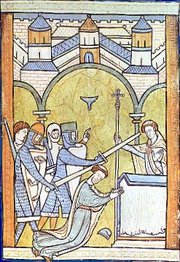Illuminated manuscript
|
|
AberdeenBestiaryFolio004vChristInMajesty.jpg
An illuminated manuscript is a manuscript in which the text is supplemented by the addition of decoration or illustration, such as decorated initials, borders and miniatures. In the strictest definition of the term, an illuminated manuscript only refers to manuscripts decorated with gold or silver. However, in both common usage and modern scholarship, the term is now used to refer to any decorated manuscript. The vast majority of surviving manuscripts are from the middle ages, although many illuminated manuscripts survive from the Renaissance, along with a very limited number from late antiquity. The majority of these manuscripts are of a religious nature. However, especially from 13th century onward, an increasing number of secular texts were illuminated. Most illuminated manuscripts were created as codices, although many illuminated manuscripts were rolls or single sheets. A very few illuminated manuscript fragments survive on papyrus. Most medieval manuscripts, illuminated or not, were written on vellum. Beginning in the late middle ages manuscripts began to be produced on paper. Illuminated manuscripts are the most common type of artifact to survive from the middle ages. They are also the best surviving indication specimens of medieval painting. Indeed, for many areas and time periods, they are the only surviving examples of painting.
For a list of pre-modern illuminated manuscripts please see List of Late Antique, Medieval, and Renaissance illuminated manuscripts.
For a look at a modern undertaking in progress right now please see http://www.saintjohnsbible.org/
| Contents |
Techniques
Illuminated.bible.arp.jpg
Illuminated.bible.closeup.arp.jpg
Illumination was a complex and frequently costly process. As such, it was usually reserved for special books: an altar Bible, for example. Wealthy people often had richly illuminated "books of hours" made, which set down prayers appropriate for various times in the liturgical day.
Text
In the making of an illuminated manuscript, the text was usually written first. Sheets of vellum, animal hides specially prepared for writing, were cut down to the appropriate size. After the general layout of the page was planned (eg initial capital, borders), the page was lightly ruled with a pointed stick, and the scribe went to work with ink-pot and either sharpened quill feather or reed pen.
The script depended on local customs and tastes. The sturdy Roman letters of the early Dark Ages gradually gave way to cursive scripts such as Uncial and half-Uncial, especially in the British Isles, where distinctive scripts such as insular majuscule and insular minuscule developed. Stocky, richly textured blackletter was first seen around the 13th century and was particularly popular in the later Middle Ages.
Images

When the text was complete, the illustrator set to work. Complex designs were planned out beforehand, probably on wax tablets, the sketch pad of the era. The design was then traced onto the vellum (possibly with the aid of pinpricks or or other markings, as in the case of the Lindisfarne Gospels).
Paints
The medi涡l artist's palette was surprisingly broad:
| Color | Source(s) |
|---|---|
| Red | Cinnabar in its natural mineral form or synthesized (also called vermillion, mercuric sulphide); "red lead" or minium (Pb3O4); insect-based colors such as cochineal and kermes; iron oxide-rich earth compounds |
| Yellow | Plant-based colors, such as saffron; yellow earth colors (ochre); orpiment (As2S3, Arsenic Sulfide) |
| Green | Plant-based compounds such as buckthorn berries; copper compounds such as verdigris and malachite |
| Blue | Ultramarine (made from the mineral lapis lazuli); azurite; smalt; plant-based substances such as woad, indigo, and folium or turnsole |
| White | Lead white (also called "flake white", basic lead carbonate (PbCO3)); chalk |
| Black | Carbon, from sources such as lamp black, charcoal, or burnt bones or ivory; sepia; iron gall |
| Gold | Gold, in leaf form (hammered extremely thin) or powdered and bound in gum arabic or egg (called "shell gold") |
| Silver | Silver, either silver leaf or powdered, as above; tin leaf |
